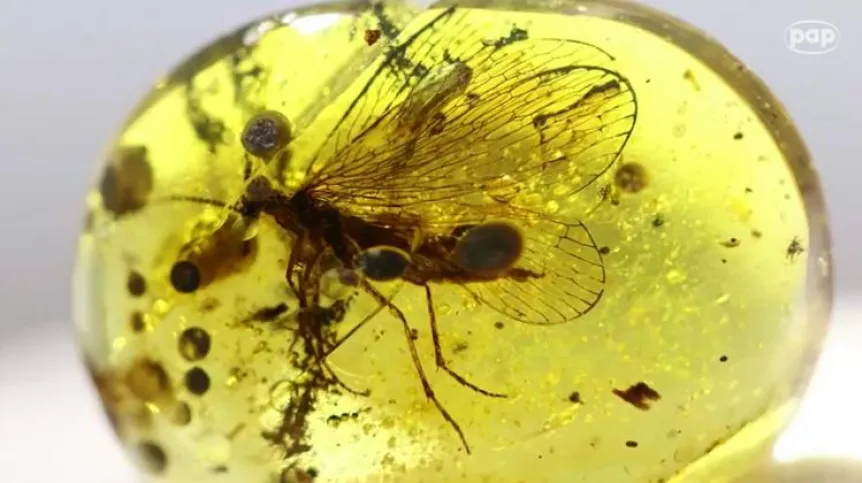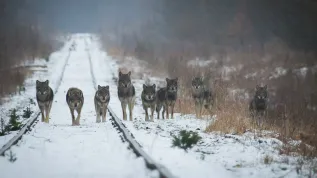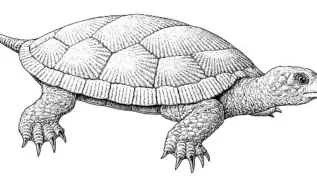
Butterflies, spiders and scorpions from almost 100 million years ago can be found in Burmese amber, exceptionally rich in inclusions. Trapped in amber, they look alive. Although they can not be used to obtain prehistoric species` DNA, they has become a window to the world of the Cretaceous period.
Amber is an extraordinary nature`s creation. It is a fossil resin of conifers, which has been subjected to fossilization (transition to a petrified state) over tens or hundreds of millions of years.

Amber. Photo: Fotolia
"A particularly interesting fact is that such an amber trap can contain traces of life from millions of years ago. Such traces of life are called inclusions. They can be of animal or plant origin" - says Dr. Agnieszka Soszyńska-Maj from the Department of Invertebrate Zoology and Hydrobiology, University of Lodz.
Until now, scientists have mostly studied inclusions in Baltic amber from northern Europe, dating back 40-50 million years. In recent years, the Burmese amber has become a sensation in the scientific world and among collectors. It is twice as old as the Baltic amber - it comes from the middle Cretaceous and is dated to approx. 99 million years ago.
Burmese amber called burmite comes mainly from Burma - a country in Southeast Asia; its current official name is Myanmar. Burmite had been mined for centuries, but in the 1930s its mines were closed. Commercial extraction was resumed after the change of the political situation in the country in 1999. Since then - through China - it has been appearing in international markets, including Europe and the United States.
"Burmese amber is a very interesting resin, because it comes from turn of the upper Cretaceous. This resin, dated to approx. 99 million years ago, is particularly rich in plant and animal inclusions" - notes the biologist who has been studying insects trapped in this amber for several years.
According to the researcher, thanks to this, in recent years, the scientific world has obtained a specific window through which it can look at life from nearly 100 million years ago. "We can admire, identify and describe plants, animals and other organisms that lived almost 100 million years ago. We see them almost as if they were alive in an amber trap, they are often preserved in perfect condition with all structures" - says Dr. Soszyńska-Maj.
Amber is a perfect trap for insects and other small invertebrates. When such an organism adheres to the resin and is completely covered by it, the access of oxygen is cut off and dehydration occurs, resulting in the preparation of the specimen. In the case of insects and other arthropods, the external chitinous shell remains and the rest of the insect is dried. "Such a specimen is in perfect condition and shape. All minor elements are preserved, they are not subject to deterioration, moulding or damage" - adds the expert.
Burmese amber most often contains small invertebrates like flies, but also larger mecopterans, beetles or butterflies. There are also much larger inclusions, and the real sensation are entirely preserved spiders (including small tarantulas), scorpions, dinosaur feathers and small snakes.
"Large amber stones with such inclusions are the objects of desire of collectors and fetch huge prices of several thousand euros. This is also a problem for us scientists, because to obtain such research materials we often have to pay for them, so unfortunately they are often unavailable for scientific research" - explains Dr. Soszyńska-Maj.
The expert dispels the dreams of acquiring DNA of prehistoric animals from amber inclusions. Studies have shown that despite the perfectly preserved shape of insects and other invertebrates, only their external chitin shells are preserved. All internal tissues are dried, and the DNA of such an animal is completely degraded.
"If we were to cut such an inclusion in half - even a beautifully preserved great scorpion - it would turn out that the scorpion is empty inside. There is only a chitin outer shell and you can not recover any tissues or DNA from such a specimen" - she emphasises.
Dr Soszyńska-Maj admits that thanks to the studies of such inclusions, the scientists gained access to the world from the middle Cretaceous, which they could only imagine before. And the more information they obtain about that world, the more accurately they can recreate the evolutionary path of particular groups of living organisms. This allows to track the evolutionary trends, animal adaptation and diversity before 100 million years.
This, in turn, allows to interpret contemporary fauna in the context of the fauna in the Cretaceous, which was a special time for living organisms. During that period, angiosperm plants dominated the vegetation and replaced the gymnosperms. This domination of angiosperm plants caused such a deep reconstruction of the natural environment and change of conditions that a huge reshaping of fauna occurred.
"In the history of living organisms, the Cretaceous is a very important moment, because since then, fauna similar to the contemporary one has begun to evolve. And yet we would not have a clue today about some organisms that lived in the Cretaceous, if it were not for the traces of life hidden in inclusions" - concludes Dr. Agnieszka Soszyńska-Maj from the University of Lodz.
PAP - Science in Poland, Kamil Szubański
szu/ ekr/ kap/
tr. RL













